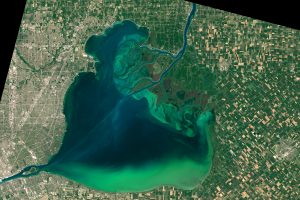Chapter 3 Composition of Substances and Solutions
Chapter 3 Composition of Substances and Solutions

Lakes have long been a source for drinking water, fishing, and human recreation. However, runoff has brought issues for such activities and resources. Runoff is excess water (usually from rain or snowmelt) that does not absorb into the land surface and carries with it anything that dissolves into the water. Thus, runoff can contain dirt, garbage from the streets, and fertilizers and pesticides used for agriculture that is drained into local bodies of water after rainfall, affecting the level of contaminants. Of specific concern are nitrogen and phosphorous, which are limiting nutrients that cause algae blooms after rain or larger storms. The U.S. Environmental Protection Agency (EPA) standard for the amount of nitrate nitrogen in lakes and reservoirs is 10 mg/L, and the criterion for phosphorous is 0.10 μg/L. If the concentration of nitrogen and phosphorous increases, then algae blooms occur in natural bodies of water, such as Lake Erie (Figure 3.1). Runoff in essential bodies of water, like Lake Erie, pollutes the drinking water for local communities, threatens wildlife, and prevents people from enjoying recreational activities (Alliance for the Great Lakes). Furthermore, low-income communities are more affected by water pollution due to inequitable funding, sociopolitical factors, and infrastructure. People of color usually reside in lower-income communities compared to White individuals due to systemic injustices, which makes water pollution an issue of both environmental justice and human rights. Regulations and the reduction of farm runoff can allow lakes and other bodies of water to maintain the healthy concentration of nitrogen and phosphorous, preventing algae blooms and thus providing safer, cleaner water for the local communities. Quantitative aspects of the composition of substances (such as the EPA standards for nitrogen and phosphorous) and mixtures (such as the lake water) are the important topics of this chapter.
Visit the US Centers for Disease Control and Prevention for information on how to detect harmful algal blooms near you [website].
Media Attributions
- Algae Bloom in Lake St. Clair © NASA Earth Observatory images by Joshua Stevens is licensed under a Public Domain license
